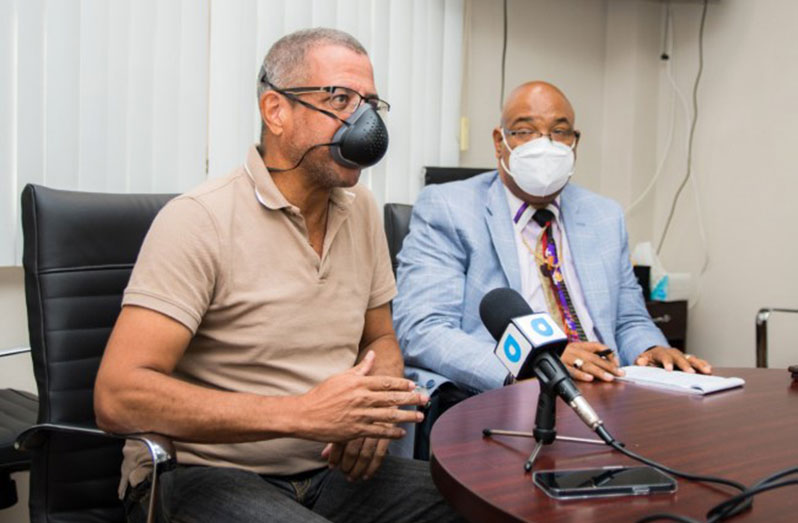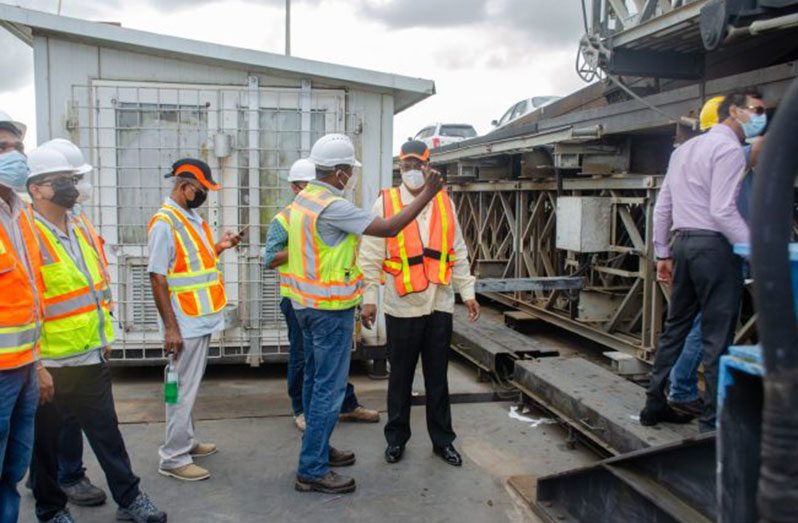-Edghill mulls placement of traffic ranks on bridge
“THE bridge cannot be opening two times a day,” said Minister of Public Works Juan Edghill, as he explained several new measures that are being implemented to reduce damage and lessen the daily traffic woes that plague the Demerara Harbour Bridge (DHB).
On Sunday, Edghill met with the technical team that was assembled to address recent damage done to ‘Span Nine’ of the floating structure. He said assessments have determined that most of the damage to the bridge is caused by speeding vehicular and marine traffic.
“We have had to put measures in place, particularly for the trucks,” Edghill said, explaining that the current damage to the bridge was caused by truck drivers applying brakes suddenly while speeding along the aged structure.

“We have to get a new culture of truckers driving on the bridge,” the minister posited. He explained that consideration is being given for police ranks to be stationed with their ‘speed guns’ along the bridge itself, so as to detect and deter speeding.
As it relates to speeding marine vessels, Edghill said that boat captains and vessel owners are among those being engaged to ensure adherence to speed limits and other precautionary measures to prevent further damages to the harbour bridge.
“Because some of them [vessels] are moving with such speed, and they are creating waves and current, they are causing misalignment to the bridge,” the Public Works Minister noted. He acknowledged too that requiring vehicles and vessels to “slow down” would most likely result in lengthier retraction times. As such, the Public Works Ministry has commenced a comprehensive analysis of travel patterns, which is expected to garner critical information for the modification of the bridge’s retraction schedule.
“That analysis will be completed within the next 48 hours,” Edghill said on Sunday.
Presently, authorities are considering the implementation of mostly night-time retractions, while only facilitating the biweekly daytime passage of tugs and barges, which are not safe to transit at nights. “We have already engaged the agents and owners of ocean-going vessels and we want that every time there is a retraction, there must be about five to six vessels passing,” Edghill noted.
Meanwhile, ‘Span Nine’ of the DHB is still not fixed. “Every effort is being made to ensure that we could get vehicles crossing the bridge, supplies can move from the east to the west and vice versa, people can get to work, and we can respond to medical and security emergencies,” Edghill said, adding that the Saturday closure of one and a half hour for emergency repairs was grossly insufficient.
“All it did was to allow us to fix one of the 272 pins to get the bridge into some shape to allow for retractions for marine traffic and to keep vehicular traffic moving,” Edghill noted.
As a temporary solution, trucks are only being allowed onto the bridge at intervals; this has resulted in the build-up of traffic along both the eastern and western ends of the bridge.
“We have to get these measures in place in a matter of hours and we are working around the clock,” Minister Edghill related.
During the meeting, engineer Marcel Gaskin reminded attendees that the DHB has outlived its lifespan and is currently showing signs of serious wear and tear. He said that efforts to fix the bridge are being rolled out in short and long-term phases. This, he explained, includes replacement of the retractor span, which is the section of the bridge that has to be opened and closed for large vessels to pass. Gaskin estimates that the bridge would be fixed within a six-month period.
“We have to design and install what we call an exoframe, which is a frame to the outside of the existing bridge structure that is going to support those panels of the retractor spans that are broken. We have to procure spare static rollers and spare travelling rollers. All these are rollers that enable the bridge to open and close. We want to have spares, so in case anything happens to the existing ones, we have those in place,” Mr. Gaskin informed the meeting.
Meanwhile, efforts are continuing for the realisation of a new Demerara River crossing. Minister Edghill had previously set out an ambitious three-year timeline for materialisation of the bridge, which is expected to be a ‘fly-over’ structure that links La Grange on the West Bank of the Demerara River, and Nandy Park on the opposite side.



.jpg)











